Hello, I’m yriel and this is my primer on how to play Creativity in Modern.
I’ve already written an extensive sideboard guide for the deck, so be sure to check it out here if you haven’t done so yet.
Don’t forget to check out Mystical Teaching’s discord channel. It’s free for everyone!
If you are not familiar with the archetype, check out the list I posted below – it’s from December 2022 sideboard guide update. It’s here to show you the general concept of the deck and what are the main goals to achieve. If you are looking for an updated list, I recommend checking the last posted sideboard guide or asking on Discord.
General concept of the archetype
The common denominator of each variant of the deck is the same main gameplan of establishing one copy of Archon of Cruelty as fast as possible (from turn 2 to turn 4 usually) or multiples later on. The supporting cast of cards like Wrenn and Six, Fable of the Mirror-Breaker, Persist, Leyline Binding, Fire//Ice or Prismari Command allow you to switch seamlessly between different gameplans. Here is a list of the most common plans you aim to execute with the deck:
- Resolving a Creativity (or Transmogrify) as soon as possible, on any target you have (preferably a Treasure), with Spell Pierce backup or not.
- Resolving a Creativity later on but with some setup, which basically means more resources to beat their interaction. Hit land drops to cast your Spell Pierces, Ice their lands to tap them low or wait for your Fable to flip – depending on the exact situation, it can be any number of those things (and others that are more contextual and thus not listed).
- Trading every resource you can one by one, playing safely and managing only necessary threats, then playing Creativity when it’s guaranteed to resolve or if it’s your last resort.
- Slowing down the game, fetching Dwarven Mine and attacking a bunch of times because they will wait for you to play Creativity. The deck contains at least 5 or 6 burn spells, with some versions running significantly more (like my current Temur list with 14 burn spells) and W6 too, so it’s quite easy to deal those last points of damage after winding them down with some 1/1s.
- Playing like a control deck, but instead of winning with Creativity for Archons, you close out the game with Wrenn’s emblem – once it’s here, you should win with all of your lands you have in hand (thanks to earlier Wrenn’s uses). Setting up the Boseiju soft lock is another way of executing this gameplan.
If you’re running Persist, you’re additionally getting some extra variations on plans A, B and C – just swap “resolve Creativity” to “discard an Archon and resolve Persist”.
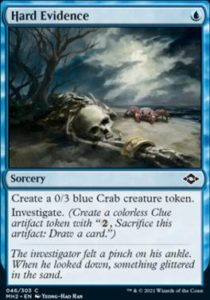
When Creativity started getting some traction last summer, the deck still ran cards like Explore or Hard Evidence, which signified more dedication towards Creativiting ASAP, whereas now, with the added interaction (Leyline Binding or Fire//Ice), the archetype is better suited for some slower plans, like B or C. The first step of any build is to choose a main plan and a couple you want to have as a consistent backup then optimising this choice. Once it’s done, you can add “flex slots” for the current metagame or try to hate a few decks (Turn the Earth against Living End for example).
Why am I not spending virtual ink talking about which tokens to target with Creativity? Because Hard Evidence is gone and Fable of the Mirror-Breaker was printed, and one of the main points of the Temur version is that you want to maximise the use of this dwarf on turn four. This dwarf is your most common combo piece, you have 4 of them and 16 ways to get it in play, and it doesn’t cost you a card. That doesn’t mean getting a token is easier than before, and it’s actually the opposite, but it means that the current lists are better at playing with this more limited access to tokens you can target with your payoff spells.
Why is it good? What is the best metagame for this deck?
The most obvious draw to the deck is that many archetypes have issues interacting with the card Indomitable Creativity. Considering you can use it on Treasures and/or multiple targets, it’s tough to counter it with removal spells (like Jund Saga or Scam are trying to do). Moreover, the deck contains powerful midrange tools, so even if your opponent has appropriate interaction (like Control or other decks with counterspells) they are the kind of matchups where your Fable, W6 and Prismari Command shine the brightest. By the virtue of how it’s constructed, the deck is generally favoured against small creatures anyway because you play W6 and Fire//Ice quite often (Merfolks, Humans or Goblins). Tron appears to be a good match-up too just because they don’t like Boseiju and Archon kills close to all their threats.
So, if we imagine a very good but realistic metagame, it could be:
- Tribal / Aether Vial decks
- Tron decks
- Solitude decks
- Ragavan / Thoughtseize decks
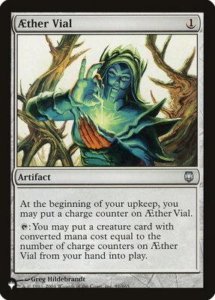
What are the deck’s biggest weaknesses?
Unsurprisingly, just like it was in case of its biggest strength, the most obvious weakness comes from decks which have an easy time dealing with Creativity (Counterspells, Discard, Engineered Explosives) for cheap, both mana and card wise. This main weakness has been reduced quite a lot with the strong midrange core (W6, Fable and Prismari Command) which fits well with the Creativity main game plan.
The other main weakness which is quite hard to overcome is decks which just don’t care about Archon (Belcher, Living End, Glimpse Combo, Twiddle Storm, Breach) because they can combo off anyway or which can go under it (Burn, Prowess, Zoo). Those decks need more specific answers, considering the aforementioned core of W6+Fable+Creativity is quite bad against them. The easiest one to solve is Zoo if you play Leyline Binding, and Living End/Burn become very winnable if you play more counterspells and Prismari Command.
Those weaknesses come from the structure, common sideboard cards like Blood Moon or Necromentia need to be taken into account in your sideboard plans but we have tools and plans for that.
One of the worst and most realistic metagames I could imagine would be:
- Red aggressive decks
- Spell-based combo decks
- Graveyard combo decks
- Most aggressive midrange decks (like Death’s Shadow)

Which version of Creativity is the best?
I will try to present my arguments on why I think this “Temur Tempo” version is one of the best for months from my point of view and even why some subpar cards like Burst Lightning, Mana Leak and Transmogrify fit well into it.
Let’s assume I want to play a Creativity deck. What are the current things I have to respect since Summer 2022 and this MH2-heavy metagame?
- Cheap interaction (Solitude, Blacksmith’s Skill, Spell Pierce, Unholy Heat, Force of Negation, Fury, Grief).
- Fast decks with creatures and/or artifacts.
- Cascade decks.
This means:
- We want to play cheap and versatile interaction too.
- Speed is not the only factor, we can’t hope to just Creativity ASAP and be done with it.
- We want the ability to prepare efficient turns.
- The deck should not rely too much on the combo.
Due to all of the above, the main game plan should be to be able to play like a tempo deck with midrange tools and cards which helps to prepare fine Creativity.
Those points led to:
- Playing more Spell Pierce, Fire//Ice, Prismari Command and removal.
- 4 Fable and 4 Wrenn and Six (which is quite standard in all builds).
- Removing cards whose only (or at least main) job was to enhance your combo potential (like Hard Evidence or Explore).
So the straight Temur version is the one which optimises for those ideas.
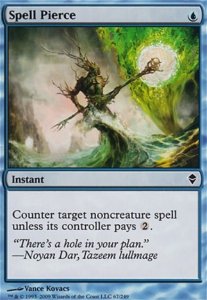
Quick notes about versions which I think are bad currently
- The old ones: Grixis Persist and 4C with Serra’s Emissary and Emrakul, they rely too much on the combo plan and have mana issues (Tainted Indulgence is hard to cast, 4C can’t cast their threats).
- Jund version with Explore/Persist/Thoughtseize/Bitter Reunion: this version still has the midrange core of W6 and Fable, but their interaction is not as efficient and it’s mostly a tap-out combo deck at this point. Moreover, discard is not at its best in Modern right now. The biggest selling point is the manabase that’s very smooth (at least by Creativity standards), but aside from that I’m not a fan – you’re running two different angles (Persist and Creativity) with less card flow/selection and less interaction that can buy you enough time to piece together the right combo.
- The Primeval Titan version (no matter the colors): the mana base is a nightmare and Titan without Amulet of Vigor is not really a great card right now. It really feels like a version which doesn’t respect the current metagame at all.
The two other versions check enough points to be looked at closely
Temur but with Persist/Bitter Reunion
In this build, you get to keep efficient blue interaction (Spell Pierce, Fire//Ice and Prismari Command) which provides one of the best enablers to Persist too. Here you will more or less be like the Jund version but with the good interaction spells which are a bit more versatile, and they will allow you to slow down the game a little and set up better Persist turns. To be honest, the deckbuilding feels quite hard and Persist is not impressive by itself. Against decks like Murktide or Hammer, you won’t have enough interaction to reach the long game, and you will need to try to combo off t4/t5 more often. The main upside here is when your interaction is not great, mainly against decks like Amulet, Burn, Prowess or Rhinos, so even though it’s better against many Temur bad matchups, it’s far worse against top decks of the format.
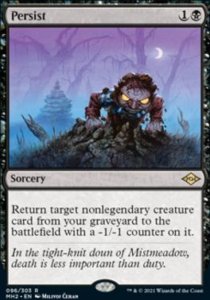
5C (Temur with Leyline Binding at least)
The comparison with straight Temur is easier here considering the difference is only a few lands (1 or 2 triomes and Sacred Foundry) and removing some average spells (Mana Leak, Burst Lightning, Transmogrify) to play Leyline Binding and a couple of Teferi, Time Raveler. The upsides are mainly to improve Murktide, Amulet and Yawgmoth MUs, turn Zoo from a hard matchup to a fine one and allow you to switch to a stronger control gameplan postboard. The reason why I don’t want to play it (but testing it is at least warranted) is the mana base. Although the cost on the decklist might seem low, it couldn’t be further from the truth in practice.
Let’s talk about the triomes, and I bet everyone will agree on these points:
- obviously, all triomes should be mountains and gather all your non-red colours (at least one green, one white, one black and two blue so).
- 2 blue mana among triomes because the deck needs them often in mid/late-game to cast Spell Pierce + any other blue spell.
- The optimal play pattern is often to play interaction on turn 2 (Leyline Binding for one mana, Lightning Bolt or Spell Pierce), which leads to Raugrim Triome and Ziatora’s Proving Ground.
- The optimal play pattern to play spells in the midgame (blue on a separate land and green/white on the same one considering it’s relatively uncommon to play Leyline Binding and W6 on the same turn compared to a blue Interaction + W6/LB), which leads to Jetmir’s Garden.
- If you have only one fetch (and let’s say Blood Crypt or Dwarven Mine) you will probably want Ketria Triome to be able to cast Ice, Bolt, Pierce and W6.
So it all means you “need” 4 different triomes to be fine in every common scenario and anyway you can’t cover them all the time. Sometimes you need to play a spell as soon as possible, you don’t have the time to get a triome, you are missing a fetch or you draw a non ideal shockland. Long story short, sequencing lands with 5C is a nightmare but if you expect decks where your upsides are huge, it will be a good choice anyway.
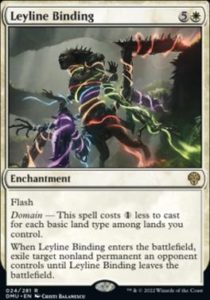
To talk a bit about the links between mirror matches and versions, the more Persists, discard and/or counterspells you play, the better it’s for you. To be brief, the only relevant cards are Wrenn, Creativity/other ways to put Archon into play and things that interact with those (you can find a more detailed overview of the mirror match in my sideboard guide).
Maindeck – card-by-card analysis
Engine
Indomitable Creativity

The heart of the deck and a reason why running such a flawed manabase is worth it. Due to how the deck functions, you need to make four land drops to be able to use it in tandem with Dwarven Mine. This means if you have a hand which relies a lot on Creativity (multiple copies, no other threats, not enough interaction to prolong the game too much etc.) you have to focus on mana and tokens.
When you’re trying to resolve it, you have to identify potential counterplay from your opponent against it:
- Don’t target a single Dwarf if you have time and your opponent plays cheap interaction for it (e.g. removal spells or Blacksmith’s Skill, which will grant it indestructibility and effectively neuter your Creativity).
- Don’t cast Creativity if they have no issue answering an Archon and continue their plan as if nothing happened (like Tron with many cards in hand and no threats on board – they will often just play Karn Liberated and exile your Archon).
- Think about what they could have in hand to deal with your tokens and/or Creativity. For example, against Solitude decks, they can kill your dwarf for zero mana whenever they want, but they have to spend 2 cards to do so, so it might be a good trade depending on what your hand looks like.
- Another important point: if you have multiple Creativities in hand, the first one can act like a “discard spell” – your opponent will spend resources to fight it and you can get some clues about how their hand looks like (for example if your UR opponent uses a Counterspell instead of Unholy Heat that probably means they don’t have any Spell Pierces or removal).
Making the game longer and waiting for an active flipped Fable or a Creativity for X=3 solves most common issues in general. If you think they have easy answers and you have time, you should wait for a good opportunity to fire. It’s very important to use the opponent’s fear of Creativity to improve your turns and play.
Do not forget Creativity can target one of your Archons to get an extra trigger faster and if the game doesn’t bode well for you, you can target any artifact or creature (Creativity on a token and a huge Murtkide if you don’t have another target on your side, or Yawgmoth/Ensnaring Bridge/other problematic permanent that deals with your plan).
Transmogrify
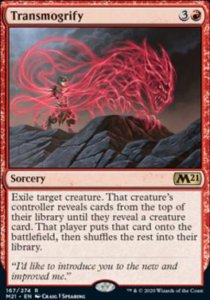
Basically additional (worse) copies of Indomitable Creativity with small differences (for instance, Transmogrify is stopped by Grafidgger’s Cage but not by Blacksmith’s Skill). The biggest downside (except for being unable to target multiple tokens) is its inability to convert Treasures into Archons, which both makes it more susceptible to removal and doesn’t work with Prismari Command as an enabler.
The more you feel the metagame is about getting Archon as soon as possible, the more you want to run some numbers of Transmogrify. It’s perfectly fine to run none at all if you feel that you’ll take on the controlling role most of the time.
Archon of Cruelty

Archon is the best payoff you can get off of Creativity in Modern, mostly due to its powerful trigger that does a lot of work even in the face of removal and because of how well it scales in multiples. It’s a good rule of thumb to count your Archons (especially the first one) as one trigger and one additional card your opponent will have to spend to deal with it, at least when facing interactive decks. Depending on your opponent’s deck, your Archon will accomplish different things. Is it enough to win by itself? Is its trigger a way to get an upper hand in an attrition war? Do you need it to stabilise against opposing pressure?
- Against UR, Scam, Amulet, Zoo, Burn, Tribal decks, Scales or Hammer for example (and all kinds of midrange decks too), an Archon is usually enough to turn the corner even if these decks have some ways to win through it.
- Against Solitude decks, other Creativity or Tron, they usually have the tools to deal with multiple Archons, so you should treat them as just a step in a larger, grindy affair. Those are the matchups in which the fourth Archon would be quite valuable.
- Against combo decks, it’s just a pretty bad clock considering it costs four mana and they probably don’t care about it too much.
I’m only running three Archons because there aren’t enough decks that warrant having the full playset, but if you’re playing Persist that’s a good reason to play four anyway.
Hardcasting an Archon is not rare, but you don’t need to rush getting black mana, especially since it can often interfere with your other plays, like holding up double countermagic or Wrenn recurring Boseiju. Sometimes there is an interesting upside to hardcast Archon like avoiding Engineered Explosives, Flusterstorm, Spell Pierce or Hallowed Moonlight, but you need to be quite confident about your handreading skills.
It is important to notice Archon needs a target so cards like Veil of Summer, Blossoming Claim or Leyline of Sanctity ‘counter’ the trigger. It’s not a huge problem if you have time to untap or if you can put multiple Archons in play, or use a different creature from the sideboard etc., but it can still matter. It just depends more on the matchup than the card which counters Archon’s trigger. For example, if you face Leyline of Sanctity from Keruga Elementals you have to sideboard in the Boseiju, Who Endrues because you need those triggers to kill their stuff. On the other hand, against Living End or Belcher you don’t care about this Leyline because your plan is to manage their combo, and winning the game is an afterthought in those cases.
Value cards that create game objects
Wrenn and Six
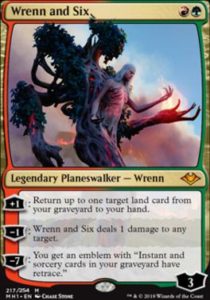
Everybody knows it’s one of the best cards in the format, and Creativity is the best home for it. Your lands have great value (fetchlands getting Dwarven Mine, Boseiju, Triomes), you want to kill early creatures (Esper Sentinel, Ragavan, Dragon’s Rage Channeler, mana dorks), it provides fuel for Prismari Command and Fable, and on top of that it serves as a win condition if you manage to get an emblem. Nonetheless, your deck doesn’t need W6 each game to work so you should just play according to how the game looks and not overprotect it. If you can kill something and you don’t need land, go on, if you can protect it just enough in order to create a second attack on it from your opponent, go on.
The Boseiju + W6 “soft lock” is quite useful against decks like Amulet, Belcher or Tron. You can win by performing this lock without any Archons whatsoever, and even a deck like Saga Breach will have some problems with winning if you destroy every Saga, Station and Breach.
Because you play a lot of damage-based removal, the damage from W6 can tag team with it to take down a larger creature, like bolting a 2/4 Ledger Shredder, Dryad or Yawgmoth and then pinging it with Wrenn. W6 can also help you with your burn plan, but be careful with it – if you use its minus targeting your opponent it will set off an alarm bell immediately for them, so consider whether “selling” another story to set up your burn spells properly isn’t worth more than this one damage. When it comes to sequencing your lands with W6, an ideal situation is getting a land with it every turn and passing a turn with a fetchland on the board as soon as you can threaten your combo.
Fable of the Mirror-Breaker
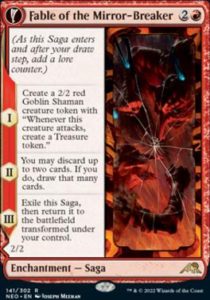
Unlike Wrenn, Fable isn’t a Modern all-star by any means, but boy does it shine in Creativity. Every part of it just lines up so well with your overall gameplan – the extra mana, tokens, possibility of getting two Archons on turn four, card selection and the potential to run away with the game if you flip it all adds to a card that basically looks tailor-made for the archetype. Playing Ice, Prismari Command or cycling while the Fable’s ability is still on the stack is relevant in the late game or in the racing situation. There are also some corner cases when it comes to the final chapter:
- Reflection of Kiki-Jiki has a mana value of 3, thus can’t be killed with Engineered Explosives on 0.
- Active Reflection lets you beat Orvar or a removal spell with a single Archon (just wait for their move before you start copying your Archons).
- Using Reflection to get additional attackers or blockers can buy you a lot of time to set up a proper Creativity later on.
- If you have two Reflections and at least one of them is active, you can use it to copy the other one in your opponent’s end step, and then use the copies to do so as many times as your mana allows you to, and then untap to attack with them.
The card shines in four main scenarios:
- If you face a fair deck (like UR or Scam), you want them to deal with full Fable and not with a 1-for-1 trade to get advantage in the resources war.
- It helps you set up a turn 4/5 Creativity with many targets from one card.
- Last but not least, sometimes you’ll just jam with it because you don’t have other options and it’ll get you there on its power level alone.
- It should be noticed this card is the only way to get non-red mana against Blood Moon so keeping it in hand if you expect it but can’t counter/destroy it otherwise is quite decent.
Prismari Command
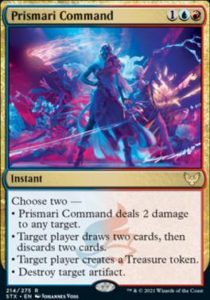
Its main role is to dig/ramp you towards Creativity as well as provide some fodder for it, so by far the most common set of modes will be looting + making a Treasure.
Only try to kill stuff with it if they are faster than you like Amulet, Hammer and Affinity, if you go to a control gameplan or if you have already a perfect hand (you don’t really want to draw Archon if you already have Creativity, interaction and mana for it).
This card should be played more carefully than Fable:
- Play it on your turn or in their upkeep if you need a mana for Spell Pierce to counter a Chord of Calling or Living End/Crashing Footfalls.
- In the lategame, if you are not under pressure, you should probably wait for other cards to have meaningful fuel for it, or for something specific to kill.
- If you have an Archon in hand, dealing 2 damage and getting a Treasure is a fine plan.
- If you don’t have any fetchlands you can discard any land and then use W6 in the main phase.
The heuristic is more or less: use the looting + Treasure mode as a default except for when you need to kill something or if you have a perfect hand. If you are on the burn plan, do not forget it can dig for more burn spells or just be a 3 mana shock.
Interaction
Fire//Ice
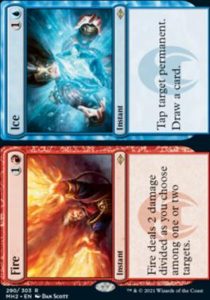
This is a pure tempo card and you will cast Ice probably 80% of the time. It’s here mainly to slow down your opponent when your hand needs some work, and in the lategame, it allows you to start a counter war on your opponent’s turn by tapping their blue mana. You should see it as a filler – it’s rarely worth it to keep it for something, and if you need something and don’t have others draw spells use Ice on anything to get back some time and/or life. The blowout of Fire killing two creatures is quite uncommon and in general, it’s a poor 2 mana Lightning Bolt when you don’t have a better removal spell in hand.
One of its main purposes is to make it easier to resolve a W6 or Fable early and to make your opponents respect your Creativity even more since you can tap the one land they keep to hold up their interaction.
There are some scenarios where the card has valuable upsides:
- Against Teferi, Time Raveler you may tap one of their lands precombat then try something in your second main phase.
- Against cascade decks, you may Ice one of their lands in their upkeep on turn three.
- In general, tap a land when they can resolve a spell which is an issue for your hand (t2 W6 in the mirror, t5 against Four Colour to avoid the Omnath+fetch pattern, t3 to avoid the EI+land or Blood Moon from UR, and so on).
- If the game goes long, you can keep your first one to wait for an extra copy and set up a more unexpected double Ice later.
- Combine it with a Bolt/W6/Command to kill an x/1 and something bigger.
- Tapping down a dashed Ragavan is good fairly often, as you’ll be able to block it with a Dwarf later on.
- Tapping the only green mana (against the mirror for example) to avoid Veil of Summer, but be careful, as they can just Veil your Ice and prevent you from drawing a card.
- If you have enough mana and creatures, you can play Creativity then tap the Archon copied by Orvar’s trigger.
It’s important to notice, with the versatility of the card and the ability to interact with nearly everything (Ice), it’s very uncommon to sideboard it out. When that’s the case, it’s because you don’t have bad cards (e.g. against Saga Breach all your removal and counterspells are good) or you need to play other spells ASAP (against Mill they have the inevitability so you have to deploy stuff and kill crabs quickly).
Lightning Bolt (and other, subpar “Bolts”)
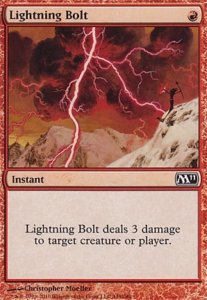
Let’s start with the easy one – Lightning Bolt is a slam dunk 4-of, as it kills close to all early threats (notable exceptions for Territorial Kavru, Ledger Shredder, Rhinos and Scion of Draco) and it can go upstairs. One advantage of damage-based removal is you can combine them to kill bigger creatures, so keeping the first one for later instead of pitching it to Fable/Command is often a good idea.
You have to be somewhat picky when it comes to using your removal while playing this deck, as you don’t have enough interaction to kill everything and you need to save it for some truly important targets. Some useful guidelines (not always true of course):
- Don’t kill Ornithopter if they don’t have Sigarda’s Aid too.
- Don’t kill Undying creatures, as they won’t kill you alone and you can focus on Grist/Yawgmoth with Bolt+Fire.
- Don’t kill Dragon’s Rage Channeler unless they play other creatures on turn 2 or if you are short on mana, let them believe it will stick for a couple of turns.
- Don’t kill the opponent’s dwarf unless they go for Creativity.
- Don’t kill Arboreal Grazear unless you need the Archon’s trigger to kill something else.
When it comes to other one-mana burn spells, they are just bad extra copies of Lightning Bolt, similarly like Transmogrify is more Creativities. They are only here if you need more of that effect, even if it’s a worse version of it. So far it seems that the upside of Burst Lightning is the most valuable, considering you easily reach 5 mana and going face is relevant. Maybe in a different metagame, another one will be good (like Dead/Gone or Unholy Heat), but being instant speed and costing one red mana are mandatory here.
Spell Pierce

To be brief – there are a bunch of proactive targets currently (Sigarda’s Aid, Colossus Hammer, Expressive Iteration, Fable, W6, Teferi, Thoughtseize, Blood Moon, Boros Charm, Crashing Footfalls, Living End, etc), and Spell Pierce has a long track record of being a great option for any deck that leverages tempo. The only world in which I could see cutting some copies is if low-curve tribal decks would make a comeback, but otherwise slowing down the opponent, protecting your threats and interacting with some sideboard cards is absolutely great.
In general, the card is played basically as soon as possible if you think you have to close the game quickly or buy some time, but if you think the game will go long you may keep it and hope that you can stockpile more than one copy for a crucial turn later on.
The incredibly important thing to understand when it comes to not only Spell Pierce, but your conditional permission in general, is that the opponent will often play in the fear of you doing something along the lines of “EOT Ice a land, untap and Creativity”. It means, for example, that if a Murktide player has 4 lands on their turn 5 and you play Spell Pierce on their Expressive Iteration, they will likely let it go. It makes Spell Pierce even more deadly.
The juiciest target you can get is Blood Moon, and everything else depends on your hand and sideboard. For example:
- If you sideboarded in Iona or Emrakul, you probably don’t care about Necromentia or Veil of Summer.
- If you have another Fable in hand, you probably don’t care about Engineered Explosives or Hidetsugu Consumes All.
- If you have a bunch of removal, you probably don’t care about Sigarda’s Aid or the first Hammer.
Mana Leak
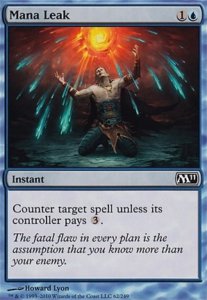
Due to your manabase, you can’t play an actual factual Counterspell, so you need to find some alternatives. Mana Leak is not a great card by itself, not at all, but it’s a decent enough catch-all and a versatile piece of interaction. It fits the deck well because you want a smooth, streamlined list, and it increases the number of counterspells so you can deal cleanly with powerful threats like Blood Moon or a big creature.
In my opinion, if you don’t go deep in the tempo game plan, you should not play it. If you want to play more on the control side Leyline Binding feels better.
Being a catch-all means it’s like having a weird mix between Bolt, Spell Pierce and Fire//Ice in hand:
- Don’t keep it if you need interaction.
- Just like with Spell Pierce, use it to make the opponent tap mana.
- If you can afford to do so, keep it for Murktide, Yawgmoth, Dryad or Titan.
- Your opponent will often play around Spell Pierce, but less so around Mana Leak.
The right number is probably between 0 and 3, the more you expect hard threats to deal with and a diverse metagame the better it becomes. For example, if you expect a bunch of UR, Hammer and Scam, and very few Amulet and mirrors, replacing it with more one-mana removal seems like a good idea.
Possible additions
Take my thoughts about black and white splash with a grain of salt, I didn’t test these options a lot, mostly theorycrafting with few leagues convinced to not dig deeper into them in the current metagame.
Black splash
Persist

The upsides of Persist are:
- The first Archon you draw during the game becomes a true piece of a 3-card combo (Persist + discard effect + Archon).
- It’s good if you need many Archons or face Archons (like against mirrors and Solitude decks where the game goes long even if a couple of them will be exiled).
- You have access to more “nut-draws”, which is useful against hard match-ups where your interaction is not very efficient (like Burn or Zoo).
The downsides:
- You need a 4th colour on turn three (because you will fetch dwarves from turn 4 onwards) which makes the mana base less smooth and requires more lands (especially fetchlands) or W6 in starting hand.
- It does nothing on its own, so if you don’t have time or a quick Archon in the graveyard, it feels like a forced mulligan sometimes.
- Using a graveyard is not an issue by itself because you can sideboard out them easily and your opponents will get blank cards against it. The card can be used as a full-on plan B (you play at least 3 of them and more discard spells), or just as a couple at maximum to get some edges in the mirror and longer games.
I don’t like it for one main reason: it doesn’t fit at all in the tempo gameplan. I want my decklist to be as smooth as possible and focus on fast games where my opponent tries to apply a huge pressure before Archon saves me. I really think there is a good version with 4 of them somewhere, that forgoes the tempo side and goes all in on midrange+combo aspects. Not sure in what hypothetical metagame it would be good, but definitely one with less Murktide and Hammer.
Bitter Reunion
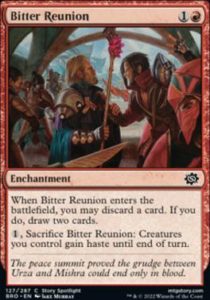
A lot of Reunion’s value is tied in giving haste to Archon which turns it into a better one-turn kill and costing only red mana. You can get extra value from it when coupled with W6, similarly to other looting spells and it makes the deck smoother in goldfish games (which are not very common at the moment). The main use of the card is to discard an Archon and then go for Persist, and its low cost will allow you to do it in one turn, avoiding any removal.
Giving haste to the Fable token or the flipped Fable can be relevant (an extra copy of Bitter Reunion on the battlefield is not very useful for Archons), and don’t forget that you’re hasting the whole team, not just a single creature. Against mirror matches, it greatly improves the “tap-out for creativity” plan, so you can rely on it even without Persist in hand.
Discard package: Thoughtseize + Inquisition of Kozilek
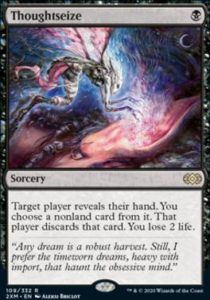
Discard spells are not at their best in modern right now. They serve a similar purpose as Spell Pierce – a cheap Interaction which can slow down the opponent or protect Creativity. The main issue with discard in this archetype comes from the difference between discard and counterspell – you really want to trade both cardboard and mana with your opponent, and discard will always be tempo negative. Additionally, you want to pick and choose cards you interact with, and it’s quite possible for a discard spell to take something that’s not that big of a problem early on and then lose to a topdecked card that could’ve been countered. If you’re on the tempo/control side, the deck is very reactive in waiting until the opponent does something relevant to interact. I guess the version where discard spells are at their best is the Jund build with Explores and multiple Transmogrifies.
Sequencing discard is much harder than counterspells. If you see 2 removal spells in the opponent’s hand you can’t go for the combo, so you most likely have to choose another path of attack (for example, take a creature and make the game longer).
The other tips about counterspells can be applied too in discards, you don’t need to play them immediately. If needed, they can be discarded to Fable/Prismari Command/Bitter Reunion, so waiting with them for a big turn to combo off is not as bad as it looks at the first glance.
It should be noted Thoughtseize is useful to catch Solitude, Murktide Regent, Titan, Orvar and your own Archon (because of Persist).
Tainted Indulgence
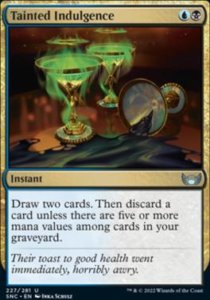
It’s more or less the best card, in general, to play in a Reanimator strategy: you can discard anything, you draw first to know what to discard, you can wait for it when you want and if the game goes long it’s a value card. The main issue (and only one to be honest) with this card is the mana cost – you need 2 non-red mana on turn two with a manabase that’s full of mountains, and you can’t play tapped Dwarven Mine on turn 1, or save 2 life on turn 2. It was played only the Grixis version without W6, which is the build that relies the most on the Persist plan. The card feels close to unplayable in the current state of the deck and Bitter Reunion feels better to use.
White splash
Teferi, Time Raveler
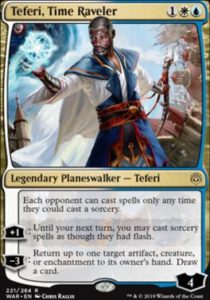
Let me be clear: Teferi is a great card in Modern, and you can try and jam it on turn three in most cases, and if you untap with it, it’s trivial to combo off, (potentially even at instant speed) plus it interacts well with the opponent’s common sideboard cards.
The white mana issue was already discussed (considering you play a few black lands even with no black cards in your deck other than Archons), but it should be noted that this issue is at its peak with Leyline Binding.
I mainly think that Teferi is no longer great because Fable was printed: generating game objects, filtering your hand and allowing a powerful proactive play is better than a planeswalker that, even if it’s powerful, doesn’t help you get towards your combo. On top of that, making room for another 3 mana sorcery speed spell isn’t easy.
Regardless of all that, Teferi has a lot of tricks and nice interactions:
- You can bounce your own Fable, Bitter Reunion or Leyline Binding.
- It interacts with hard strategies to deal with (Cascade and Reforge the Soul from Belcher).
- Bouncing Urza’s Saga is one of the best tempo plays ever.
- Its passive makes your life much easier, but don’t overcommit to protecting it.
Leyline Binding and Prismatic Ending

Just like Teferi, those are some great Modern cards right now, with Leyline Binding being quite better than Prismatic Ending. It allows you to deal with close to any threat you could face pretty quickly, with its biggest blind spot being turn 1 Ragavan while you’re on the draw.
The same manabase concerns as with Teferi apply here. If I would advise running these removal spells, it’s in order to deal with decks like Zoo, Yawgmoth, Amulet or Merfolk. I’m also a firm believer the Leyline Binding version is by far the best against Murktide too because it allows you to go full on the control game plan. The important remark, from my point of view, is to acknowledge that these matchups (except Zoo) are close to favourable for the Temur list as well.
Some remarks about Leyline Binding:
- It changes the way you sequence your lands drastically (take a look at the “which version of Creativity is the best” section in order to learn more about it).
- You can deal with Archon copies from Orvar, Engineered Explosives, Amulet, Sigarda’s Aid, Aether Vial, W6, Yawgmoth early on for a low cost (usually dealing with those costs either more mana or requires more time).
- Leyline Binding only answers Blood Moon if you have five mana to cast it, which makes it a pretty bad answer for it.
- Keep in mind that opponents can interact with your Bindings with stuff like their own Bindings, Boseiju, other Disenchant effects and so on.
The manabase
There are two major guidelines that your manabase should follow:
- Make Creativity into a “one-card combo”, so getting Dwarven Mine repeatedly should be easy.
- Cast your spells in a smooth fashion and be able to eventually hardcast an Archon.
You have to play 4 Dwarven Mine, especially if you’re not running some outdated cards like Hard Evidence.
Based on common Frank Karsten’s numbers used to build mana bases:
- 14 green sources should be the minimum (even if some of them are tapped) to cast W6 on turn 2.
- 14 untapped blue sources should be the minimum to cast Spell Pierce to turn 1.
Now let’s check some numbers (approximations based on hypergeometric distribution) when it comes to getting some interesting combinations of lands. If you’re playing my recommended manabase of 12 fetchlands, 4 shocklands, 2 triomes, 1 basic Mountain and 4 Dwarven Mine, you have:
- 72% to get at least 2 untapped lands (so Dwarven Mine is excluded) in the starting hand.
- 83% to get at least 2 mountains (so Dwarven Mine is included) in the starting hand.
- 91% to get at least one non-Dwarven Mine land if you already have a Dwarven Mine in the starting hand.
- 82% to get 3 mountains (Dwarven Mine is included) by turn 3 on the play.
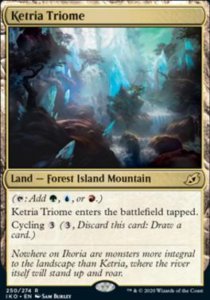
It’s quite hard to draw a clear and good line at a specific number. Personally, I feel fine with “80% of the time I won’t have a specific issue except for an early tapland sometimes”.
In my opinion, the mana base is more or less locked with 23 lands: 12 or 13 fetchlands, 4 Dwarven Mine, 1 Basic Mountain, at least one shockland for each of your colours, at least one black land somewhere and a couple of triomes if the format is not degenerately fast. You want the 2nd Steam Vents if you play a lot of Fire//Ice and counterspells because you will need to double-spell with blue cards on turns 3 and 4 quite often. Considering you play 2 Steam Vents, you should have 2 green Triomes. Double green is only useful for W6 + Boseiju (which means that against Hammer, Amulet, Belcher, URx Breach and Tron the first triome has a great value in the long run).
Then you can add utility lands (because you play 4 W6). Currently, Boseiju, Who Endures is by far the best land to solve common issues like:
- Urza’s Saga and Hammer against Hammer’s Time, sometimes Esper Sentinel to avoid the tax and get an upside if they use a Blacksmith’s Skill on it.
- Mainly Urza’s Saga and Amulet of Vigor against Amulet Titan, a karoo land if they have many Amulets or a Dryad if it’s late in the game.
- Any land against Belcher because they don’t have any land to grab with Boseiju and sometimes Belcher/Blood Moon if they already have 3 lands.
- Against Tron you target only their Urza lands, it shuts down the use of Karn, the Great Creator and Oblivion Stone anyway.
- Mainly Underworld Breach against URx Breach deck considering it’s not hard to deal with the creatures and draw spells.
- Sometimes it’s an answer against Blood Moon or Engineered Explosives against UR or Scam, but that’s pretty rare and only used for that in those matchups.
- Using Boseiju on a Leyline Binding with his trigger still on the stack means your permanent will never leave the battlefield (like a W6 with a lot of counters), obviously if it targets an Archon you’re happy to let it get exiled first.
- It’s pretty rare, but it can disrupt opposing Creativity which targets a flipped Fable or Treasure.
A quick note about the 2nd Boseiju that I played very often in the main deck – It’s basically a 16th sideboard card that I wanted to fit somewhere, and I’m quite happy to respect a powerful high tiers deck like Hammer. It’s fine to play more utility lands (even Otawara or Sokenzan) or add a 3rd triome, but it leads to deck space issues more than anything else.
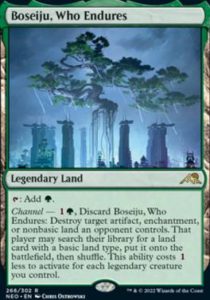
As far as other versions go, I think you have to follow the same rules (with the exception of the “2 blue mana” one if you don’t play a high number of Fire//Ice, Spell Pierce and Mana Leak) and find the others common scenarios to solve with different triomes or the number of shocklands.
A few examples:
- If you’re playing Temur with Persist, Xander’s Lounge is a bad idea because you will want to play Persist and a counterspell.
- If you’re playing 5 colours, Raugrin Triome is quite good because it can pay for any cheap interaction spell on turn 2
Last point – I think that the number of black sources is not a solved thing. It really depends on the number of times you hardcast Archon without using a Treasure. So far, I like the not-so-rare combination of cycling the Triome + W6, but fetching both black lands has been pretty uncommon for me.
Sideboard options
Veil of Summer
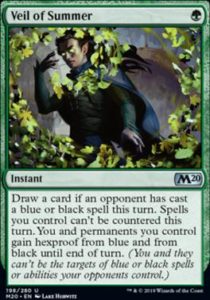
This card is a house with an absurd raw power level. You play a deck that needs cheap interaction and protection, and this card should be brought close to each time your opponent plays blue or black. Basically, if your opponent plays any counterspell, discard or anything that targets you and/or interacts with Creativity/Archon (like Necromantia and Grist) you should use it, the only relevant exception is if the Nature’s Claim/Boseiju (for example, against Hammer or URx Breach) or Aether Gust/Flusterstorm (for example, against URx Prowess) package is better.
The card feels like you need to have it in your sideboard, considering it’s good against half of the hard matchups (generally cascade decks and mirrors) and very often useful. You can go up to 4 without any problem, for example, if Flusterstorm or Aether Gust is average in your local metagame.
As far as bringing Veil against decks that’ll have Orvar as the only thing your Veil will interact with, you can have them in if you don’t have a good plan B and no other great cards to use instead, but that’s really rare. For example, against Scales, you can go for the control game plan and wait to have a flipped Fable to win through one Orvar.
Nature’s Claim
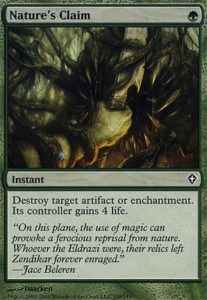
The deck contains a lot of cheap interaction, but counterspells and burn spells won’t manage Urza’s Saga or artifacts/enchantments from the very first turn of the game that easily. If you don’t play Leyline Binding, you should probably play at least 2 and maybe 4 of them as long as Hammer and Amulet are popular.
Basically, you board it in every time it kills a lot of targets that are good against you and/or are the backbone of the opponent’s gameplan. For example, you don’t bring it in against Fable or Leyline Binding, considering you are not afraid of these cards at all. The main targets are Urza’s Saga, Colossus Hammer, Sigarda’s Aid, Amulet of Vigor, Dryad of the Ilysian Grove and Blood Moon (on paper). The issue with Blood Moon is that the decks that play it usually have only a couple of them, as well as other ways to interact with you, and it’s not their main game plan at all so it’s pretty rare to have Claim in against something like Murktide or Scam. Another not-so-obvious example is Aether Vial tribal decks like Merfolks and Goblins. They kinda need this tempo advantage Vial gives to compete with you, and sometimes they have some other juicy targets (like Blood Moon from Goblins), plus you have some useless or average counterspells to remove anyways.
Flusterstorm
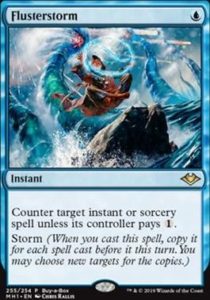
You should basically view those as more copies of Spell Pierce, but with more specific targets. The card is well-known to be great against cascade decks, which is also true here, but otherwise, they are, once again, more copies of Spell Pierce. So cascade decks and any deck which relies on counterspells are the main targets, and you can bring also it in when it’s a strict improvement of Spell Pierce too (for example against Yawgmoth instead of some Spell Pierces and against Belcher or Burn because it interacts against 80% of their spells).
Flusterstorm is pretty straightforward and the comparison with Spell Pierce makes it easy to use it, even against decks like UR Prowess or UR Breach when they don’t have that many targets but you want more interaction nonetheless so it’s still fine.
Turn the Earth

Let’s start with the obvious remarks. Turn the Earth is in the deck to interact with the graveyard directly (something you don’t have at all in the main deck no matter which version you play), with an upside to gain some life. So you use it against graveyard-heavy decks, Burn and Prowess, and it can be situationally good against other things like Yawgmoth, Scam or even Murktide, but it’s much more conditional.
The card was added to the board for one reason only: having something relevant against Living End and Burn, and it appears that Turn the Earth completely wraps the Living End match-up:
They interact very poorly with it (Mystical Dispute costs 3, Boseiju, Otawara, Brazen Borrower, Force of Vigor all deal with Leyline of the Void but not Turn the Earth).
You can easily play around Force of Negation by casting it in their upkeep on turn three or just by waiting for them to go for the cascade spell. Flashback also makes it great against a single Grief most of the time.
You don’t need to blank 100% of their Living End, as Living End that only brings back 1 or 2 creatures (especially some weaker ones) is easy to beat, especially so if you have an Archon in your graveyard.
You can think about sandbagging it if your opponent hasn’t seen it with Grief to maximise the blow out potential.
I’m mostly talking about Living End because if it disappears from the metagame, you can just run other cards that are better in different matchups, like Hallowed Moonlight or Leyline of the Void.
There aren’t any real counterintuitive cases for it, just keep in mind it’s an average sideboard card against UR, Scam or Yawgmoth and it should be used only if your matchup even with the rest of the sideboard feels poor.
Weather the Storm
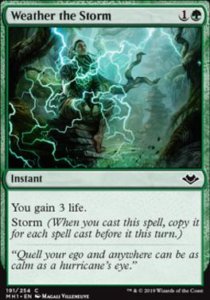
Your match-ups against very aggressive and spells-based decks are very difficult in general so gaining a huge amount of life should give you enough time to set up an Archon properly. Currently, it’s only good against Burn and UR Prowess. Aside from these matchups, it’s kind of a useless card and all of Turn The Earth, Collective Brutality, or Aether Gust could be better to solve some similar issues.
I am not 100% sure but I think it’s a trap against Grapeshot combo decks, they expect interaction anyway, it costs you 2 mana, and they can replay Grapeshot or have their own Flusterstorm.
Boseiju, Who Endures

As I said above in the mana base section, it has a lot of interesting uses and you play W6, so getting more copies allows you to get a strong plan B of Boseiju + W6 kind of as your wincon instead of a Creativity. You will bring it mainly against Urza’s Saga decks or when it deals with very annoying targets you could not manage with your main deck interaction (board in Boseiju first over Nature’s Claim against Leyline of Sanctity for example).
The card is so versatile that you should have at least 2 of them in the 75 and more is rarely a bad choice. Remember that Boseiju is a land, so if W6 is really poor you can board out some of them and board in Boseiju to improve your chances of getting to your 3/4th land drop easily (sure you won’t get a Dwarf, but you’ll still able to cast Creativity on a Treasure or a Goblin).
Aether Gust
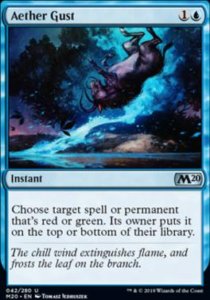
Aether Gust is a bit like Flusterstorm or Nature’s Claim, it’s just a way to improve your interaction because your main deck have issues dealing with big green creatures (Titan, Dryad, Rhinos, Territorial Kavru, Grist) and red spells in general (Blood Moon, Fury, burn spells, Monastery Swiftspear). The card is quite obvious to use so, if you face a couple of cards you absolutely need to delay in order to get some time to play Creativity, well Aether Gust works just fine.
As long as Scam, Rhinos and Titan are high-tier decks, it feels hard to not play 1 or 2 if you don’t have other versatile cards to do the job.
I’m pretty sure the card is bad against Murktide because they don’t have that many red spells and they can easily just replay those that are crucial later on (Blood Moon and Iteration), so any sort of counterspell that can protect your Creativity is better.
Iona, Shield of Emeria

Your sideboard needs to have some other creature than Archon of Cruelty and this additional creature has to solve issues that Archon doesn’t. Iona is great when your opponent plays unfair strategies or at least something you have issues interacting with (like Burn). If you think disallowing your opponent to play a specific spell makes you win close to all the time it’s probably a good idea to bring it in. It fills the role of being a 4th target, no matter what it is, because some matchups require that, but in general, it provides great upsides (like saying white against any Solitude decks).
Iona is good against a bunch of bad matchups (notable exceptions being Rhinos and Prowess), so I don’t really see a world in which I don’t play her.
Emrakul, the Aeons Torn
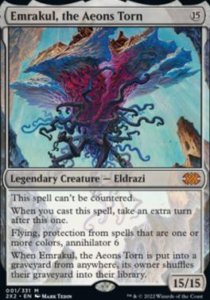
Like Iona, it’s an option for the additional creature slot. This one allows you a true one-turn kill, which is not always true with Archon and it can be better than Archon if your opponent can deal with it. I think the card is pretty good against fair strategies so, for example, you can remove all your Archons for Emrakul to respect Orvar or to have a couple of additional interactions.
Considering I value Iona highly, the only scenario where I would want to run Emrakul is if Orvar becomes insanely popular.
Don’t bring it in against combo decks, as you usually want to get an Archon trigger in as soon as possible, and having Emrakul in your deck makes is somewhat likely that your Creativity on turn four will have no immediate effect.
Leyline of the Void

It’s a possible graveyard interaction for the deck, as it solves the Leyline issue quite well by looting away ones you don’t need. To be honest though, I dislike the card in a tempo gameplan, as it’s a brute force card which might fit well in the deck but not necessarily in the gameplan, and I’m quite confident that Turn the Earth is better against the main target of Leyline of the Void (which is Living End).
So I think you should probably include it if you don’t have a well-tuned (which might not be possible to achieve depending on the version you’re on) game plan against Yawgmoth, Scam, Breach and UR, but if you’re running a straight Temur build I’d advise against having them in your sideboard.
Unmoored Ego

It offers a somewhat unique axis of interaction by managing a crucial card before the opponent is able to cast it, which is closer to Thoughtseize than any counterspell. It is useful if you can’t counter or deal efficiently over and over with a particular card, or if you expect the game to go long and you want to get an edge in your opponent never drawing this crucial card.
You will use it against any unfair decks, mirror and Solitude decks, so if your metagame doesn’t have those just don’t run it. Considering the mana cost, playing 2 at maximum seems reasonable.
I think the card is kind of obvious to use, even if there are some corner cases where it’s relevant to use despite your opponent not playing unfair high-impact cards (one of them is Solitude). Another major downside of the card is that it seems bad against Crashing Footfalls because it can get countered by Mystical Dispute and delayed by their Ice. Moreover, if they resolve Footfalls before you cast it, you will probably lose if you can’t put an Archon in play (and Unmoored Ego doesn’t help you a lot on that).
Brotherhood’s End

Unlike other cards mentioned above, I don’t think there is a single version where you want to play this card:
- You have access to a good control plan so killing stuff is easy.
- You have access to a good tempo plan so you want cheap interaction.
- You have access to a good combo plan so you probably want to stay on it.
If you think it’s good against Hammer, just imagine them playing any counterspell or Blacksmit’s Skill in response or just having an Inkmoth Nexus or Urza’s Saga on board. Feels like a win-more card when there are a bunch of losing scenarios where it’s bad.
